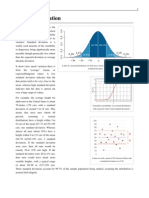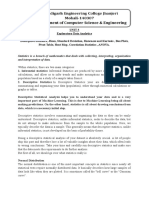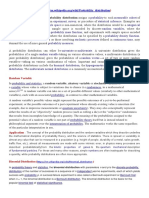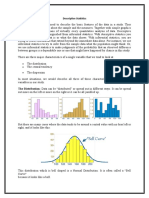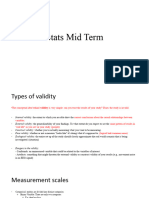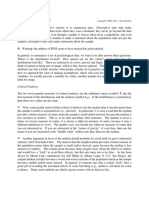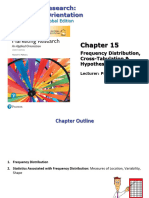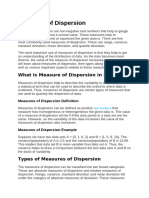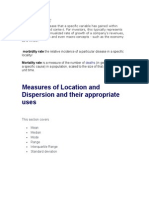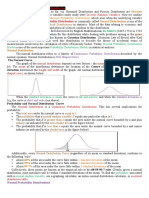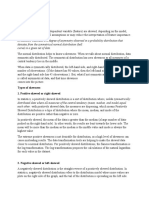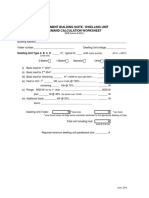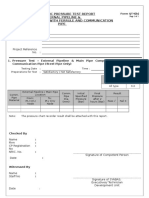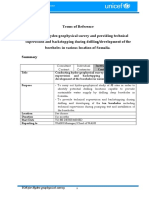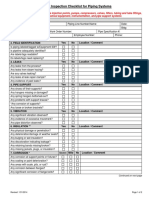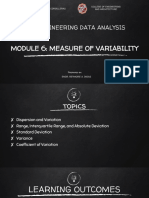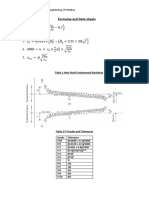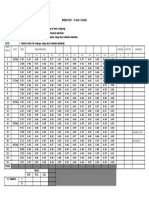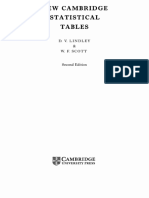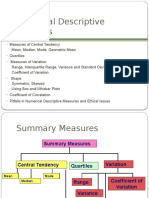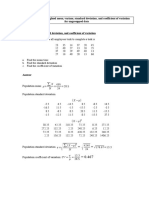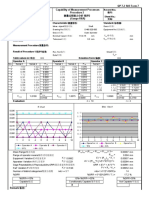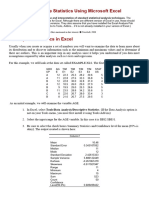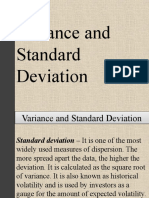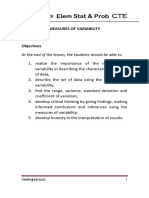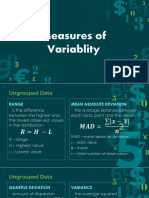Dispersion: Handout #7
Dispersion: Handout #7
Uploaded by
Bonaventure NzeyimanaCopyright:
Available Formats
Dispersion: Handout #7
Dispersion: Handout #7
Uploaded by
Bonaventure NzeyimanaOriginal Description:
Original Title
Copyright
Available Formats
Share this document
Did you find this document useful?
Is this content inappropriate?
Copyright:
Available Formats
Dispersion: Handout #7
Dispersion: Handout #7
Uploaded by
Bonaventure NzeyimanaCopyright:
Available Formats
Handout #7
POLI 300
N. R. Miller
MEASURES OF DISPERSION (VARIABILITY)
While measures of central tendency indicate what value of a variable is (in one sense or
other, e.g., mode, median, mean), average or central or typical in a set of data, measures of
dispersion (or variability or spread) indicate (in one sense or other) the extent to which the observed
values are spread out around that center how far apart observed values typically are from each
other or from some average value (in particular, the mean). Thus:
(a)
if all cases have identical observed values (and thereby also all have the average
value), dispersion is zero;
(b)
if most cases have observed values that are quite close together (thereby also quite
close to the average value), dispersion is low (but greater than zero); but
(c)
if many cases have observed values that are quite far apart from many others (or
from the average value), dispersion is high.
A measure of dispersion provides a summary statistic that indicates the magnitude of such dispersion
and, like a measure of central tendency, is a univariate statistic.
Because dispersion is concerned with how close together or far apart observed values
are (i.e., with the magnitude of the intervals between them), it should be apparent that the notion of
dispersion make sense and measures of dispersion are defined only for interval (or ratio)
variables. (There is one exception: a very crude measure of dispersion called the variation ratio,
which is defined for ordinal and even nominal variables. It will be discussed briefly in the Answers
& Discussion to PS #7.)
There are two principal types of measures of dispersion: range measures and deviation
measures.
Range Measures
Range measures are based on the distance between (relatively) extreme values observed
in the data and are conceptually connected with the median as a measure of central tendency (See
the data illustrating Percentiles, the Median, and Ranges on the back page of the Handout #6 on
Measures of Central Tendency.)
The (total or simple) range is the maximum (highest) value observed in the data (the
value of the case at the 100th percentile) minus the minimum (lowest) value observed in the data (the
value of the case at the 0th percentile) that is, the distance or interval between the values of
these two extreme cases. (Note that this may be less than the range of the possible values of the
variable, since logically possible extreme values may not be observed in actual data; for example,
the variable LEVEL OF TURNOUT has logically possible values ranging from 0% to 100%, but in
U.S. Presidential elections, the range of observed values [as conventionally measured, i.e., as Total
Vote for President divided by Voting Age Population] over the past 60 years or so ranges from a
minimum observed of about 48% (in 1996) to about 64% (in 1960). The problem with the (total or
simple) range as a measure of dispersion is that it depends on the values of just two cases cases
that by definition have atypical (and perhaps extraordinarily atypical) values. In particular, the range
#7 Dispersion
page 2
makes no distinction between a polarized distribution in which almost all observed values are close
to either the minimum or maximum values and a distribution in which almost all observed values
are bunched together but there are a few extreme outliers. Also the range is undefined for theoretical
distributions that are open-ended (the technical term is asymptotic), like the normal distribution
(that we will take up in the next topic) or the upper end of an income distribution type of curve (see
PS #5C). Therefore other variants of the range measure that do not reach entirely out to the extremes
of the frequency distribution are often used in place of the total range.
The interdecile range is the value of the case that stands at the 90th percentile of the
distribution minus the value of the case that stands at the 10th percentile that is, the distance
or interval between the values of these two less extreme cases. In like manner, the interquartile
range is the value of the case that stands at the 75th percentile of the distribution minus the value
of the case that stands at the 25th percentile. (The first quartile is the median observation among
all cases that lie below the overall median and the third quartile is the median observation among
all cases that lie above the overall median. In these terms, the interquartile range is third quartile
minus the first quartile.)
We have previously used a range measure in a special context. The handout on Random
Sampling said the following:
Suppose the Gallup Poll takes a random sample of n respondents and reports that
the President's current approval rating is 62% and that this sample statistic has a margin of
error of 3 %. Here is what this means: if (hypothetically) Gallup were to take a great many
random samples of the same size n from the same population (e.g., the American VAP on
a given day), the different samples would give different statistics (approval ratings), but 95%
of these samples would give approval ratings within 3 percentage points of the true
population parameter.
Thus, if our data is the list of sample statistics produced by the (hypothetical) great many
random samples, the margin or error specifies the range between the value of the sample statistic that
stands at the 97.5th percentile minus the sample statistic that stands at the 2.5th percentile (so that
95% of the sample statistics lie within the range). Specifically (and letting P be the value of the
population parameter) this range is (P + 3%) !(P ! 3%) = 6%, i.e., twice the margin error.
Deviation Measures
Deviation measures are based on average deviations from some average value. (Recall the
discussion of Deviations from the Average in Handout #6 on Measures of Central Tendency.) Since
we are dealing with interval variables, we can calculate means, and deviation measures are typically
based on the mean deviation from the mean value. Thus the usual deviation measures are conceptually connected with the mean as a measure of central tendency.
Suppose we have a variable X and a set of cases numbered 1,2, . . . , n. Let the observed
value of the variable in each case be designated x1, x2, etc. Thus:
mean of X = Gx =
x1 + x2 +...+ xn
3x
____________
= ___ .
n
n
#7 Dispersion
page 3
The deviation from the mean for a representative case i is (xi ! Gx ). If almost all of these
deviations are small (if almost all cases are close to the mean value), dispersion is small; but if many
of these deviations are large (if many cases are much above or below the mean), dispersion is large.
This suggests we could construct a measure D of dispersion that would simply be the average (mean)
of all the deviations:
D =
3 (xi ! Gx )
(x1 ! Gx ) + (x2 ! Gx ) + ... + (xn ! Gx )
___________________________ = ________
.
n
n
But this will not work, because some of the deviation are positive and others are negative
and, as we saw earlier (Handout #6, point (d) under Deviations from the Average), these positive and
negative deviations necessarily balance out and add up to zero, i.e., for any distribution of
observed values 3(xi ! Gx ) = 0.
A practical way around this problem is simply to ignore the fact that some deviations are
negative while others are positive by averaging the absolute values of the deviations (in effect, by
ignoring the negative sign before each negative deviation):
3 *xi ! Gx *
________ .
n
This measure (called the mean deviation) tells us the average (mean) amount that the values
for all cases deviate (regardless of whether they are higher or lower) from the average (mean) value.
Indeed, this is an intuitive, understandable, and perfectly reasonable measure of dispersion, and it
is occasionally used in research.
MD =
However, statisticians are mathematicians, and they dislike this measure because the formula
is mathematically messy by virtue of being non-algebraic (in that it ignores negative signs).
Therefore statisticians, and most researchers, use another slightly different deviation measure of
dispersion that is algebraic, and that makes use of the fact that the square of any (positive or
negative) number (i.e., the number multiplied by itself) other than zero is itself always positive. This
formula is based on finding the average of the squared deviations; since these are all non-negative,
they do not balance out. This measure of dispersion is called the variance of the variable.
3 (xi ! Gx )2
Variance of X = Var(X) = s 2 = _________
.
n
That is, the variance is the average squared deviation from the mean. Remember from
Handout #6 (point (e) under Deviations from the Average) that the average squared deviation from
the mean value of X is smaller than the average squared deviation from any other value of X. The
variance is the usual measure of dispersion in statistical theory, but it has a drawback when
researchers want to describe the dispersion in data in a practical way. Whatever units the original
data (and its average values and its mean dispersion) are expressed in, the variance is expressed in
the square of those units, and thus it doesn't make much intuitive or practical sense. This can be
remedied by finding the (positive) square root of the variance (which takes us back to the original
units). This measure of dispersion is called standard deviation of the variable:
#7 Dispersion
page 4
__________
/ 3 (xi ! Gx )2
Standard Deviation of X = SD(X) = s = / _________ .
r
n
In order to interpret a standard deviation, or to make a plausible estimate of the SD of some
data, it is useful to think of the mean deviation because (i) it is easier to estimate the magnitude of
the mean deviation and (ii) the standard deviation has approximately the same numerical magnitude
as the mean deviation. More precisely, given any distribution of data, the standard deviation is never
less than the mean deviation; it is equal to the mean deviation if the data is distributed in a
maximally polarized fashion; otherwise the SD is somewhat larger typically about 20-50%
larger.
Sample Estimates of Population Dispersion
Random sample statistics that are percentages or averages provide unbiased estimates of the
corresponding population parameters. However, sample statistics that are dispersion measures
provide estimates of population dispersion that are biased (at least slightly) downward. This is most
obvious in the case of the range; it should be evident that a sample range is almost always smaller,
and can never be larger, than the corresponding population range. The sample standard deviation
(or variance) is also biased slightly downward . (While the SD of a particular sample can be larger
than the population SD, sample SDs are on average slightly smaller than the corresponding population SDs). However, the sample SD can be adjusted to provide an unbiased estimate of the
population SD; this adjustment consists of dividing the sum of the squared deviations by n !1, rather
than by n. (Clearly this adjustment makes no practical difference unless the sample is quite small.
Notice that if you apply the SD formula in the event that you have just a single observation in your
sample, i.e., n = 1, it must give SD = 0 regardless of what the observed value is. More intuitively,
you can get no sense of how much dispersion there is in a population with respect to some variable
until you observe at least two cases and can see how far apart they are.) This is why you will often
see the formula for the variance and SD with an n !1 divisor (and scientific calculators often build
in this formula). However, for POLI 300 problem sets and tests, you should use the formula given
in the previous section of this handout.
Dispersion in Ratio Variables
Given a ratio variable (e.g. income), the interesting dispersion question may pertain not to
the interval between two observed values or between an observed value and the mean value but to
the ratio between the two values. (For example, one household poverty level is defined as one
half the median household income, and households with more than twice the median income are
sometimes characterized as well off. The average compensation of CEOs today is about 250 times
that of the average worker, whereas 50 years it was only about 40 times that of the average worker.)
The degree of dispersion in ratio variables can naturally be referred to as the degree inequality. One
ratio measure of dispersion/inequality is the coefficient of variation, which is simply the standard
deviation divided by the mean. Another is the Gini Index of Inequality, which is based on a
comparison between the actual cumulative distribution when cases are ranked ordered from lowest
#7 Dispersion
page 5
to highest value (e.g., from poorest to richest) and the cumulative distribution that would exist if all
cases had the same value.
How to Compute a Standard Deviation
The formula for the standard deviation is:
__________
/ 3 (xi ! Gx )2
SD(X) = s = / _________ .
r
n
Here is how to use the formula.
1.
Set up a worksheet like the one shown below.
2.
In the first column, list the values of the variable X for each of the n cases. (This is the raw
data.)
3.
Find the mean value of the variable in the data, by adding up the values in each case and
dividing by the number of cases.
4.
In the second column, subtract the mean from each value to get, for each case, the deviation
from the mean. Some deviations are positive, others negative, and (apart from rounding
error) they must add up to zero; add them up as an arithmetic check.
5.
In the third column, square each deviation from the mean, i.e., multiply the deviation by
itself. Since the product of two negative numbers is positive, every squared deviation is nonnegative, i.e., either positive or (in the event a case has a value that coincides with the mean
value).
6.
Add up the squared deviations over all cases.
7.
Divide the sum of the squared deviations by the number of cases; this gives the average
squared deviation from the mean, commonly called the variance.
8.
The standard deviation is the (positive) square root of the variance. (The square root of x
is that number which when multiplied by itself gives x.)
#7 Dispersion
page 6
You might also like
- Power Plant Commissioning ProcedureDocument1 pagePower Plant Commissioning ProcedureBonaventure NzeyimanaNo ratings yet
- Standard Size of Rooms in Residential BuildingDocument4 pagesStandard Size of Rooms in Residential BuildingBonaventure Nzeyimana75% (4)
- EOI Document 23rdjuly FinalDocument42 pagesEOI Document 23rdjuly FinalBonaventure NzeyimanaNo ratings yet
- 01 Site DiaryDocument3 pages01 Site DiaryBonaventure NzeyimanaNo ratings yet
- Consulting Invoice TemplateDocument1 pageConsulting Invoice TemplateBonaventure NzeyimanaNo ratings yet
- Chapter Two Mba Summary Class Notes 24Document31 pagesChapter Two Mba Summary Class Notes 24Cosmas KipkoechNo ratings yet
- Measures of Dispersion - IIDocument41 pagesMeasures of Dispersion - IISanghamitra SanyalNo ratings yet
- Measures of DispersionDocument43 pagesMeasures of DispersionMiranda RiskiNo ratings yet
- StatisticsDocument743 pagesStatisticsmunish_tiwari2007100% (1)
- Statistical and Probability Tools For Cost EngineeringDocument16 pagesStatistical and Probability Tools For Cost EngineeringAhmed AbdulshafiNo ratings yet
- Standerd DiviationDocument14 pagesStanderd DiviationPrageeth Nalaka ArambegedaraNo ratings yet
- Business Analytics AssignmentDocument5 pagesBusiness Analytics AssignmentRichard NarcisoNo ratings yet
- Amit Singh - Ssjcet20024 - Business Statistic AssignmentDocument14 pagesAmit Singh - Ssjcet20024 - Business Statistic AssignmentSushma YadavNo ratings yet
- Measures of DispersionDocument3 pagesMeasures of DispersionAbrar AhmadNo ratings yet
- How To Find The MeanDocument4 pagesHow To Find The Meanapi-150547803No ratings yet
- Multivariate Analysis: Descriptive Statistics Is The Discipline of Quantitatively Describing The Main Features of ADocument5 pagesMultivariate Analysis: Descriptive Statistics Is The Discipline of Quantitatively Describing The Main Features of AMegumi FujiNo ratings yet
- Definition MeanDocument4 pagesDefinition Meanapi-140032165No ratings yet
- Standard DeviationDocument22 pagesStandard Deviationdev414No ratings yet
- Unit-3 DS StudentsDocument35 pagesUnit-3 DS StudentsHarpreet Singh BaggaNo ratings yet
- PME-lec8-ch4-bDocument50 pagesPME-lec8-ch4-bnaba.jeeeNo ratings yet
- What Is MeanDocument4 pagesWhat Is Meanapi-143521979No ratings yet
- Mids UnitDocument13 pagesMids Unit2344Atharva PatilNo ratings yet
- Statistics For DatacienceDocument7 pagesStatistics For DatacienceNIKHILESH M NAIK 1827521100% (1)
- Continuous Probability DistributionsDocument8 pagesContinuous Probability DistributionsLupita JiménezNo ratings yet
- MayhsDocument4 pagesMayhsNorbert LimNo ratings yet
- Descriptive Statistics MBADocument7 pagesDescriptive Statistics MBAKritika Jaiswal100% (2)
- Measures of VariabilityDocument1 pageMeasures of VariabilityElma rejanoNo ratings yet
- Find MeanDocument4 pagesFind Meanapi-140032165No ratings yet
- Statistical Machine LearningDocument12 pagesStatistical Machine LearningDeva Hema100% (1)
- Stats Mid TermDocument22 pagesStats Mid TermvalkriezNo ratings yet
- Standard DeviationDocument11 pagesStandard DeviationJAHLEL SHELAH TRILLESNo ratings yet
- Standard Deviation - Wikipedia, The Free EncyclopediaDocument12 pagesStandard Deviation - Wikipedia, The Free EncyclopediaManoj BorahNo ratings yet
- 05 Descriptive Statistics - DistributionDocument5 pages05 Descriptive Statistics - DistributionAce ChoiceNo ratings yet
- Stats and Prob Reviewer, Q3 Jess Anch.Document8 pagesStats and Prob Reviewer, Q3 Jess Anch.JessicaNo ratings yet
- Intrduction To Behavioural Statistics: Essays-Question 3Document2 pagesIntrduction To Behavioural Statistics: Essays-Question 3Jodyann Likrisha McleodNo ratings yet
- What Can I Write in Mid TermDocument5 pagesWhat Can I Write in Mid TermAna ChikovaniNo ratings yet
- BAA Class NotesDocument16 pagesBAA Class Notesprarabdhasharma98No ratings yet
- Normal DistributionsDocument11 pagesNormal DistributionsWaseem Javaid SoomroNo ratings yet
- Descriptive Statistics: Central TendencyDocument3 pagesDescriptive Statistics: Central TendencySayanta BasuNo ratings yet
- Ae9 - Activity 5Document15 pagesAe9 - Activity 5BONILLA, Mary Jane, C.No ratings yet
- Statistical TreatmentDocument7 pagesStatistical TreatmentKris Lea Delos SantosNo ratings yet
- Measure of Central Tendency Dispersion ADocument8 pagesMeasure of Central Tendency Dispersion Aرؤوف الجبيريNo ratings yet
- Standard Deviation-From WikipediaDocument11 pagesStandard Deviation-From WikipediaahmadNo ratings yet
- Mosconi W1Document14 pagesMosconi W1muzammilbabar91No ratings yet
- Gurruh Dwi Septano Tugas Rangkuman BAB 2Document16 pagesGurruh Dwi Septano Tugas Rangkuman BAB 2gurruh dwi septanoNo ratings yet
- Normal Probability DistributionDocument6 pagesNormal Probability DistributionJayson Bernales Ga MonteNo ratings yet
- Marketing ResearchDocument16 pagesMarketing ResearchiherbfirstorderNo ratings yet
- Measures of DispersionDocument6 pagesMeasures of DispersionpadmavathiNo ratings yet
- Descriptive StatisticsDocument1 pageDescriptive StatisticsNor Azila ChIeylaNo ratings yet
- MathgrrDocument11 pagesMathgrrClyde HugoNo ratings yet
- Summary Statistics, Distributions of Sums and Means: Joe FelsensteinDocument21 pagesSummary Statistics, Distributions of Sums and Means: Joe FelsensteinmhdstatNo ratings yet
- Unit 4 Descriptive StatisticsDocument8 pagesUnit 4 Descriptive StatisticsHafizAhmadNo ratings yet
- Statistics MyNotesDocument61 pagesStatistics MyNotesVengatesh JNo ratings yet
- Measures of Location and Dispersion and Their Appropriate UsesDocument7 pagesMeasures of Location and Dispersion and Their Appropriate UsesAnonymous 8rsxG4No ratings yet
- M3.Normal Distribution - Final PDFDocument23 pagesM3.Normal Distribution - Final PDFÖzZíé Ming RenNo ratings yet
- M3.Normal Distribution - Final PDFDocument23 pagesM3.Normal Distribution - Final PDFÖzZíé Ming RenNo ratings yet
- Skewness Kurtosis and HistogramDocument4 pagesSkewness Kurtosis and HistogramAdamu MadiNo ratings yet
- Business Statistics & Analytics For Decision Making Assignment 1 Franklin BabuDocument9 pagesBusiness Statistics & Analytics For Decision Making Assignment 1 Franklin Babufranklin100% (1)
- Unit 1 - Business Statistics & AnalyticsDocument25 pagesUnit 1 - Business Statistics & Analyticsk89794No ratings yet
- Lecture 3 Notes - PSYC 204Document8 pagesLecture 3 Notes - PSYC 204SerenaNo ratings yet
- 1 Descriptive Statistics - UnlockedDocument18 pages1 Descriptive Statistics - UnlockedNidaOkuyazTüregünNo ratings yet
- The Standard DeviationDocument70 pagesThe Standard DeviationFedericoNo ratings yet
- Standard Deviation and VarianceDocument18 pagesStandard Deviation and VarianceIzi100% (3)
- Damages in Hydraulic Turbines 2Document13 pagesDamages in Hydraulic Turbines 2Bonaventure NzeyimanaNo ratings yet
- Best Practices For Standby Generator Operations and MaintenanceDocument12 pagesBest Practices For Standby Generator Operations and MaintenanceBonaventure Nzeyimana100% (1)
- Hydraulic SystemDocument5 pagesHydraulic SystemBonaventure NzeyimanaNo ratings yet
- Cooling of A Synchronous GeneratorDocument3 pagesCooling of A Synchronous GeneratorBonaventure Nzeyimana100% (1)
- Apt BLDG Suite Calc WorksheetDocument1 pageApt BLDG Suite Calc WorksheetBonaventure NzeyimanaNo ratings yet
- Pressure Test Sample Form R2Document1 pagePressure Test Sample Form R2Bonaventure Nzeyimana100% (1)
- Form QT4 (B)Document2 pagesForm QT4 (B)Bonaventure NzeyimanaNo ratings yet
- Family Name: Pelosi 2. First Name: Alfonso: Curriculum VitaeDocument6 pagesFamily Name: Pelosi 2. First Name: Alfonso: Curriculum VitaeBonaventure NzeyimanaNo ratings yet
- WKS 1 Excavations ACOP Fire Explosions in Underground Mines TunnelsDocument186 pagesWKS 1 Excavations ACOP Fire Explosions in Underground Mines TunnelsBonaventure NzeyimanaNo ratings yet
- Attachment To LRPS-2017-9135981 Hydro-Geophysical Study - ANNEX B - TORDocument11 pagesAttachment To LRPS-2017-9135981 Hydro-Geophysical Study - ANNEX B - TORBonaventure NzeyimanaNo ratings yet
- 0901b80380959cc7 PDFDocument2 pages0901b80380959cc7 PDFBonaventure NzeyimanaNo ratings yet
- Acute Kidney FailureDocument4 pagesAcute Kidney FailureBonaventure NzeyimanaNo ratings yet
- Request For InspectionDocument1 pageRequest For InspectionBonaventure NzeyimanaNo ratings yet
- Resident Engineer Responsibilities and DutiesDocument2 pagesResident Engineer Responsibilities and DutiesBonaventure Nzeyimana100% (3)
- Tipstertube Com Match 3216449Document8 pagesTipstertube Com Match 3216449Bonaventure NzeyimanaNo ratings yet
- Hydropower - Key To Sustainable, Socio-Economic Development of BhutanDocument7 pagesHydropower - Key To Sustainable, Socio-Economic Development of BhutanBonaventure NzeyimanaNo ratings yet
- Part of A Long ReportDocument5 pagesPart of A Long ReportBonaventure NzeyimanaNo ratings yet
- Module 7 - Measures of VariabilityDocument16 pagesModule 7 - Measures of VariabilityallankatenguddoNo ratings yet
- Formulae and Data SheetDocument3 pagesFormulae and Data SheetHemantNo ratings yet
- VariabilityDocument20 pagesVariabilityMr crab rave100% (1)
- Calculate Standard DeviationDocument3 pagesCalculate Standard DeviationMarkusNo ratings yet
- 3 Xbar S Chart Exercise PDFDocument1 page3 Xbar S Chart Exercise PDFTuan AnhNo ratings yet
- Analisis Soal Ulangan HarianDocument12 pagesAnalisis Soal Ulangan Hariannurul11109No ratings yet
- Statistical Tables and Formula ListDocument14 pagesStatistical Tables and Formula ListEdward TanNo ratings yet
- Fit Symbol 50H8/d9 100H7/ 60 /h12Document21 pagesFit Symbol 50H8/d9 100H7/ 60 /h12Prajwal ShakyaNo ratings yet
- CH 03Document40 pagesCH 03AlexanderNo ratings yet
- Demand Metrics Excel TemplateDocument14 pagesDemand Metrics Excel TemplateumeshjmangroliyaNo ratings yet
- Numerical Descriptive Measures 1Document39 pagesNumerical Descriptive Measures 1Dolores AbanganNo ratings yet
- Lesson II: Measures of Variability: Example 1Document21 pagesLesson II: Measures of Variability: Example 1Analyn Bintoso DabanNo ratings yet
- Math 9 1ST QuarterDocument56 pagesMath 9 1ST QuarterEric De GuzmanNo ratings yet
- Soal Latihan Pertemuan 2 (Bahasa Inggris)Document3 pagesSoal Latihan Pertemuan 2 (Bahasa Inggris)balchieyNo ratings yet
- Quality Assurance: QP 7.2 S03 Form 7 Capability of Measurement Processes Procedure 2 程序2 (Gauge R&R)Document20 pagesQuality Assurance: QP 7.2 S03 Form 7 Capability of Measurement Processes Procedure 2 程序2 (Gauge R&R)cong daNo ratings yet
- JL and Lucille CRD Stat2Document8 pagesJL and Lucille CRD Stat2Jevelyn Mendoza FarroNo ratings yet
- 52Document81 pages52bahaNo ratings yet
- Mengatasi Heteroskedastisitas Pada Regresi DenganDocument7 pagesMengatasi Heteroskedastisitas Pada Regresi DenganAnonymous 1KkcOZ3RCNo ratings yet
- Descriptive Statistics Using Microsoft ExcelDocument5 pagesDescriptive Statistics Using Microsoft ExcelVasant bhoknalNo ratings yet
- LS Particle Size Analyzer Beckman Coulter LS 13 320Document3 pagesLS Particle Size Analyzer Beckman Coulter LS 13 320hariNo ratings yet
- Assignment 3Document9 pagesAssignment 3Peng GuinNo ratings yet
- Jam003mqn400 406Document1 pageJam003mqn400 406Sebastian Davila hernandezNo ratings yet
- UntitledDocument11 pagesUntitledOmja DwivediNo ratings yet
- S&P SamplingDocument3 pagesS&P SamplingChristine Mae GonzalesNo ratings yet
- Gridding Report - : Data SourceDocument7 pagesGridding Report - : Data SourceDian RizqaNo ratings yet
- Variance and Standard DeviationDocument44 pagesVariance and Standard DeviationJeffrey AragonNo ratings yet
- Math 153 Chapter 4Document9 pagesMath 153 Chapter 4knowledgerandom2No ratings yet
- AAR and CAAR CalculationDocument23 pagesAAR and CAAR CalculationrajloniNo ratings yet
- Measures of Variability 32729Document15 pagesMeasures of Variability 32729Kloie SanoriaNo ratings yet
- Week 2 Measures of Dispersion IIDocument34 pagesWeek 2 Measures of Dispersion IITildaNo ratings yet










